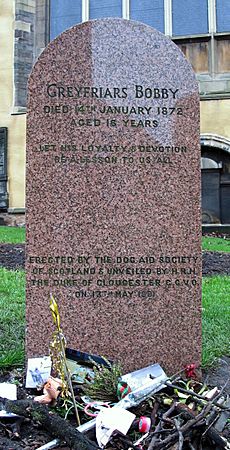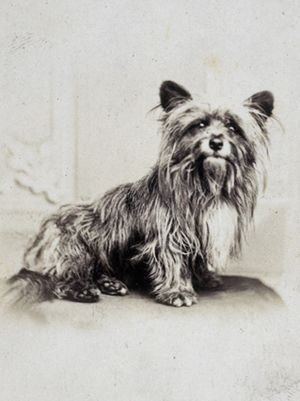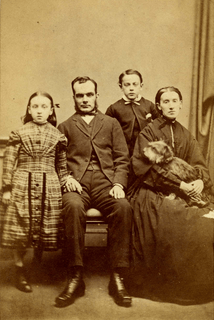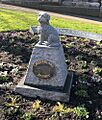Greyfriars Bobby facts for kids

This statue of Bobby sits at the corner of Edinburgh's Candlemaker Row and George IV Bridge, and is a Category A listed building
|
|
| Breed | Skye Terrier or Dandie Dinmont Terrier |
|---|---|
| Born | 4 May 1855 Edinburgh, Scotland |
| Died | 14 January 1872 (aged 16) Edinburgh, Scotland |
| Resting place | Greyfriars Kirkyard |
| Known for | Guarding the grave of his owner until he died himself on 14 January 1872 |
| Owner | John Gray |
| Awards | Key to the City of Edinburgh |
Greyfriars Bobby was a famous dog from the 1800s. He was either a Skye Terrier or a Dandie Dinmont Terrier. Bobby became well-known in Edinburgh, Scotland, because he spent 14 years guarding his owner's grave. He stayed there until he died on January 14, 1872. His story is still very popular in Scotland, told in many books and movies. There's even a special statue and graves nearby that many tourists visit.
Contents
The Famous Story of Bobby
The most popular version of Bobby's story says he belonged to John Gray. John Gray worked as a nightwatchman for the Edinburgh City Police. When John Gray passed away, he was buried in Greyfriars Kirkyard. This is a churchyard around Greyfriars Kirk in Edinburgh's Old Town.
Bobby then became famous in the area. He spent the rest of his life sitting on his master's grave. People were amazed by his loyalty.
In 1867, the leader of Edinburgh, Sir William Chambers, helped Bobby. He was also involved with an animal welfare group. Sir William paid for Bobby's dog license and gave him a special collar. This collar can now be seen at the Museum of Edinburgh.
Bobby is said to have stayed by the grave for 14 years. He died in 1872. A vet, Prof Thomas Walley, examined him and found he had cancer of the jaw.
Bobby was buried just inside the gate of Greyfriars Kirkyard. His grave is not far from John Gray's.
A year later, a kind person from England, Lady Burdett-Coutts, loved Bobby's story. She paid for a drinking fountain to be built with a statue of Bobby on top. The statue was made by William Brodie. It stands at the corner of George IV Bridge and Candlemaker Row, across from the churchyard.
Who Was John Gray?
John Gray (who died on February 15, 1858) was often called Old John. He was a gardener who moved to Edinburgh in 1850 with his family. To avoid going to a workhouse, he joined the Edinburgh City Police as a nightwatchman.
Around this time, he looked after Greyfriars Bobby. Bobby would follow John Gray while he was working. Police officers back then were expected to have watchdogs with them.
One story says John Gray was a farmer who visited a coffee house daily. However, this might not be completely true. John Gray reportedly died from tuberculosis in 1858. He was buried in Greyfriars Kirkyard. For 14 years, Bobby stayed by his master's grave.
In 2018, John Gray's grave was damaged.
Different Ideas About the Story
Over the years, people have wondered how true the stories about Greyfriars Bobby are. Some books, like those by Forbes Macgregor and Jan Bondeson, have looked into this.
Questions about the story's accuracy are not new. As far back as 1934, a newspaper article discussed these questions. People who claimed to have known the dog personally sometimes had different ideas about the story's details.
One common discussion is about which John Gray was Bobby's true owner. There were two people named John Gray: one was the night watchman, and the other was a farmer.
Jan Bondeson suggests that some basic facts about Bobby might be wrong. He points out that in the 1800s, there were over 60 stories of dogs living in graveyards in Europe. These were often stray dogs that visitors and caretakers fed. People started to believe these dogs were waiting by a grave, so they took care of them.
Bondeson thinks that after an article about Bobby appeared in a newspaper, more people visited the graveyard. This might have helped local businesses. He also guesses that the original Bobby might have died in 1867 and been replaced by a younger dog. This would explain why Bobby lived so long.
A book published in 2022 suggested Bobby was probably a Dandie Dinmont Terrier instead of a Skye Terrier. This idea came from Mike Macbeth, who leads a Dandie Dinmont Terrier club in Canada. He noted that Dandie Dinmont Terriers were very popular in Scotland at the time. There were about 60 breeders in the Edinburgh area. Skye Terriers, however, were mostly found on the Isle of Skye.
Memorials to Bobby

- Greyfriars Bobby Fountain: This fountain has a life-size statue of Bobby. It was made by William Brodie in 1872. Baroness Burdett-Coutts paid for it. This monument is Edinburgh's smallest listed structure.
- Greyfriars Bobby's Bar: This is a pub located near the fountain on Candlemaker Row.
- Greyfriars Bobby's Headstone: The Dog Aid Society of Scotland put up this headstone. The Duke of Gloucester officially revealed it on May 13, 1981. The stone reads: "Greyfriars Bobby – Died 14 January 1872 – Aged 16 years – Let his loyalty and devotion be a lesson to us all".
- New Memorial in Kirkyard: In 2021, a new monument was placed near the east wall of Greyfriars Kirk. This was to mark 150 years since Bobby's death.
Books and Films About Bobby
- The True Story of Greyfriars Bobby (1902): This was an early historical account by Henry T. Hutton.
- Greyfriars Bobby (1912): This novel by Eleanor Atkinson added more details to the story. It made John Gray a shepherd known as "Auld Jock." The 1961 Walt Disney film, Greyfriars Bobby: The True Story of a Dog, was based on this book.
- The Adventures of Greyfriars Bobby (2006): This film starred James Cosmo and Christopher Lee. Some people were surprised that a West Highland Terrier was chosen to play Bobby. Also, new characters were added, and John Traill, an important person in Bobby's life, was left out.
See also
 In Spanish: Greyfriars Bobby para niños
In Spanish: Greyfriars Bobby para niños
- Bobbie the Wonder Dog
- Dog on the Tuckerbox
- Fido (dog)
- Hachikō
- Kostya
- List of individual dogs
Images for kids





